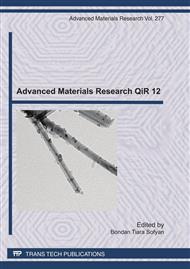p.90
p.100
p.106
p.112
p.120
p.129
p.137
p.143
p.151
Study of the Electical Conductivity of Oil Palm Fiber Carbon
Abstract:
The physical properties of carbon from natural fibers are strongly influenced by the conditions of carbonization process. Temperature carbonization process of natural fibers affects the structure and electrical properties of carbon. This research studied the influence of carbonization process to the electrical conductivity and the microstructure of carbon from oil palm fibers. Oil palm fiber carbonization process has been carried out at the temperature of 500°C and 900°C for 1 hour in the atmosphere of inert gas (nitrogen) and at a temperature of 1300°C performed using a Spark Plasma Sintering (SPS). Structure of oil palm fiber carbon analyzed using XRD and SEM, electrical conductivity measurements carried out using LCR meter. XRD data analysis showed that the carbon structure is amorphous, and carbonization process up to 1300°C cause increase of the degree of crystallinity, that are 36.92%, 39.07% and 42.48% for 500°C, 900°C and 1300°C respectively. Increase of carbonization temperature also causes the electrical conductivity of carbon that are (3.3 x10-6) S/m – (4.8 x10-6) S/m for carbon 500°C, 1.29 S/m – 1.3 S/m for carbon 900°C, and (1.4 x10) S/m – (1.7 x10) S/m for carbon 1300°C.
Info:
Periodical:
Pages:
137-142
Citation:
Online since:
July 2011
Authors:
Keywords:
Price:
Сopyright:
© 2011 Trans Tech Publications Ltd. All Rights Reserved
Share:
Citation:


